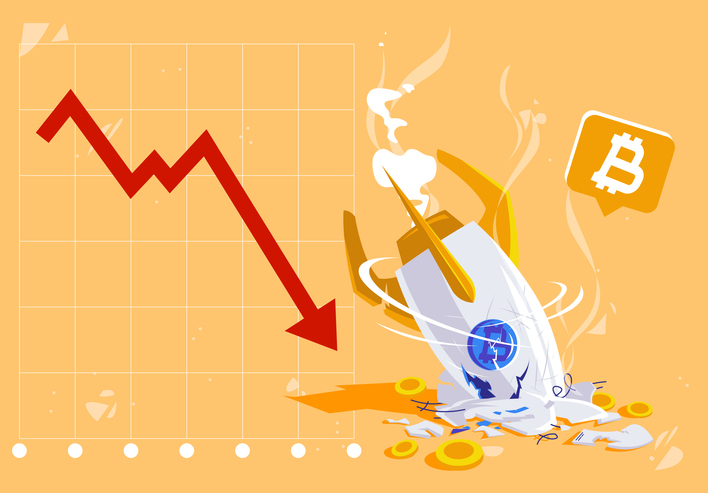How Crypto’s Collapse May Have Done the Economy a Favour
Crypto’s lack of connections with traditional finance means its problems haven’t spilled over to the economy
This year’s crypto collapse has all the hallmarks of a classic banking crisis: runs, fire sales, contagion.
What it doesn’t have are banks.
Check out the bankruptcy filings of crypto platforms Voyager Digital Holdings Inc., Celsius Network LLC and FTX Trading Ltd. and hedge fund Three Arrows Capital, and you won’t find any banks listed among their largest creditors.
While bankruptcy filings aren’t entirely clear, they describe many of the largest creditors as customers or other crypto-related companies. Crypto companies, in other words, operate in a closed loop, deeply interconnected within that loop but with few apparent connections of significance to traditional finance. This explains how an asset class once worth roughly $3 trillion could lose 72% of its value, and prominent intermediaries could go bust, with no discernible spillovers to the financial system.
“Crypto space…is largely circular,” Yale University economist Gary Gorton and University of Michigan law professor Jeffery Zhang write in a forthcoming paper. “Once crypto banks obtain deposits from investors, these firms borrow, lend, and trade with themselves. They do not interact with firms connected to the real economy.”
A few years from now, things might have been different, given the intensifying pressure on regulators and bankers to embrace crypto. The crypto meltdown may have prevented that—and a much wider crisis.
Crypto has long been marketed as an unregulated, anonymous, frictionless, more accessible alternative to traditional banks and currencies. Yet its mushrooming ecosystem looks a lot like the banking system, accepting deposits and making loans. Messrs. Gorton and Zhang write, “Crypto lending platforms recreated banking all over again… if an entity engages in borrowing and lending, it is economically equivalent to a bank even if it’s not labeled as one.”
And just like the banking system, crypto is leveraged and interconnected, and thus vulnerable to debilitating runs and contagion. This year’s crisis began in May when TerraUSD, a purported stablecoin—i.e., a cryptocurrency that aimed to sustain a constant value against the dollar—collapsed as investors lost faith in its backing asset, a token called Luna. Rumours that Celsius had lost money on Terra and Luna led to a run on its deposits and in July Celsius filed for bankruptcy protection.
Three Arrows, a crypto hedge fund that had invested in Luna, had to liquidate. Losses on a loan to Three Arrows and contagion from Celsius forced Voyager into bankruptcy protection.
Meanwhile FTX’s trading affiliate Alameda Research and Voyager had lent to each other, and Alameda and Celsius also had exposure to each other. But it was the linkages between FTX and Alameda that were the two companies’ undoing. Like many platforms, FTX issued its own cryptocurrency, FTT. After this was revealed to be Alameda’s main asset, Binance, another major platform, said it would dump its own FTT holdings, setting off the run that triggered FTX’s collapse.
Genesis Global Capital, another crypto lender, had exposure to both Three Arrows and Alameda. It has suspended withdrawals and sought outside cash in the wake of FTX’s demise. BlockFi, another crypto lender with exposure to FTX and Alameda, is preparing a bankruptcy filing, the Journal has reported.
The density of connections between these players is nicely illustrated with a sprawling diagram in an October report by the Financial Stability Oversight Council, which brings together federal financial regulators.
To historians, this litany of contagion and collapse is reminiscent of the free banking era from 1837 to 1863 when banks issued their own bank notes, fraud proliferated, and runs, suspensions of withdrawals, and panics occurred regularly. Yet while those crises routinely walloped business activity, crypto’s has largely passed the economy by.
Some investors, from unsophisticated individuals to big venture-capital and pension funds, have sustained losses, some life-changing. But these are qualitatively different from the sorts of losses that threaten the solvency of major lending institutions and the broader financial system’s stability.
To be sure, some loan or investment losses by banks can’t be ruled out. Banks also supply crypto companies with custodial and payment services and hold their cash, such as to back stablecoins. Some small banks that cater to crypto companies have been buffeted by large outflows of deposits.
Traditional finance had little incentive to build connections to crypto because, unlike government bonds or mortgages or commercial loans or even derivatives, crypto played no role in the real economy. It’s largely been shunned as a means of payment except where untraceability is paramount, such as money laundering and ransomware. Much-hyped crypto innovations such as stablecoins and DeFi, a sort of automated exchange, mostly facilitate speculation in crypto rather than useful economic activity.
Crypto’s grubby reputation repelled mainstream financiers like Warren Buffett and JPMorgan Chase & Co. Chief Executive Jamie Dimon, and made regulators deeply skittish about bank involvement. In time this was bound to change, not because crypto was becoming useful but because it was generating so much profit for speculators and their supporting ecosystem.
Several banks have made private-equity investments in crypto companies and many including J.P. Morgan are investing in blockchain, the distributed ledger technology underlying cryptocurrencies. A flood of crypto lobbying money was prodding Congress to create a regulatory framework under which crypto, having failed as an alternative to the dollar, could become a riskier, less regulated alternative to equities.
Now, stained by bankruptcy and scandal, cryptocurrency will have to wait longer—perhaps forever—to be fully embraced by traditional banking. An end to banking crises required the replacement of private currencies with a single national dollar, the creation of the Federal Reserve as lender of last resort, deposit insurance and comprehensive regulation.
It isn’t clear, though, that the same recipe should be applied to crypto: Effective regulation would eliminate much of the efficiency and anonymity that explain its appeal. And while the U.S. economy clearly needed a stable banking system and currency, it will do just fine without crypto.
 Copyright 2020, Dow Jones & Company, Inc. All Rights Reserved Worldwide. LEARN MORE
Copyright 2020, Dow Jones & Company, Inc. All Rights Reserved Worldwide. LEARN MORE
This stylish family home combines a classic palette and finishes with a flexible floorplan
Just 55 minutes from Sydney, make this your creative getaway located in the majestic Hawkesbury region.
Continued stagflation and cost of living pressures are causing couples to think twice about starting a family, new data has revealed, with long term impacts expected
Australia is in the midst of a ‘baby recession’ with preliminary estimates showing the number of births in 2023 fell by more than four percent to the lowest level since 2006, according to KPMG. The consultancy firm says this reflects the impact of cost-of-living pressures on the feasibility of younger Australians starting a family.
KPMG estimates that 289,100 babies were born in 2023. This compares to 300,684 babies in 2022 and 309,996 in 2021, according to the Australian Bureau of Statistics (ABS). KPMG urban economist Terry Rawnsley said weak economic growth often leads to a reduced number of births. In 2023, ABS data shows gross domestic product (GDP) fell to 1.5 percent. Despite the population growing by 2.5 percent in 2023, GDP on a per capita basis went into negative territory, down one percent over the 12 months.
“Birth rates provide insight into long-term population growth as well as the current confidence of Australian families,” said Mr Rawnsley. “We haven’t seen such a sharp drop in births in Australia since the period of economic stagflation in the 1970s, which coincided with the initial widespread adoption of the contraceptive pill.”
Mr Rawnsley said many Australian couples delayed starting a family while the pandemic played out in 2020. The number of births fell from 305,832 in 2019 to 294,369 in 2020. Then in 2021, strong employment and vast amounts of stimulus money, along with high household savings due to lockdowns, gave couples better financial means to have a baby. This led to a rebound in births.
However, the re-opening of the global economy in 2022 led to soaring inflation. By the start of 2023, the Australian consumer price index (CPI) had risen to its highest level since 1990 at 7.8 percent per annum. By that stage, the Reserve Bank had already commenced an aggressive rate-hiking strategy to fight inflation and had raised the cash rate every month between May and December 2022.
Five more rate hikes during 2023 put further pressure on couples with mortgages and put the brakes on family formation. “This combination of the pandemic and rapid economic changes explains the spike and subsequent sharp decline in birth rates we have observed over the past four years,” Mr Rawnsley said.
The impact of high costs of living on couples’ decision to have a baby is highlighted in births data for the capital cities. KPMG estimates there were 60,860 births in Sydney in 2023, down 8.6 percent from 2019. There were 56,270 births in Melbourne, down 7.3 percent. In Perth, there were 25,020 births, down 6 percent, while in Brisbane there were 30,250 births, down 4.3 percent. Canberra was the only capital city where there was no fall in the number of births in 2023 compared to 2019.
“CPI growth in Canberra has been slightly subdued compared to that in other major cities, and the economic outlook has remained strong,” Mr Rawnsley said. “This means families have not been hurting as much as those in other capital cities, and in turn, we’ve seen a stabilisation of births in the ACT.”
This stylish family home combines a classic palette and finishes with a flexible floorplan
Just 55 minutes from Sydney, make this your creative getaway located in the majestic Hawkesbury region.






















